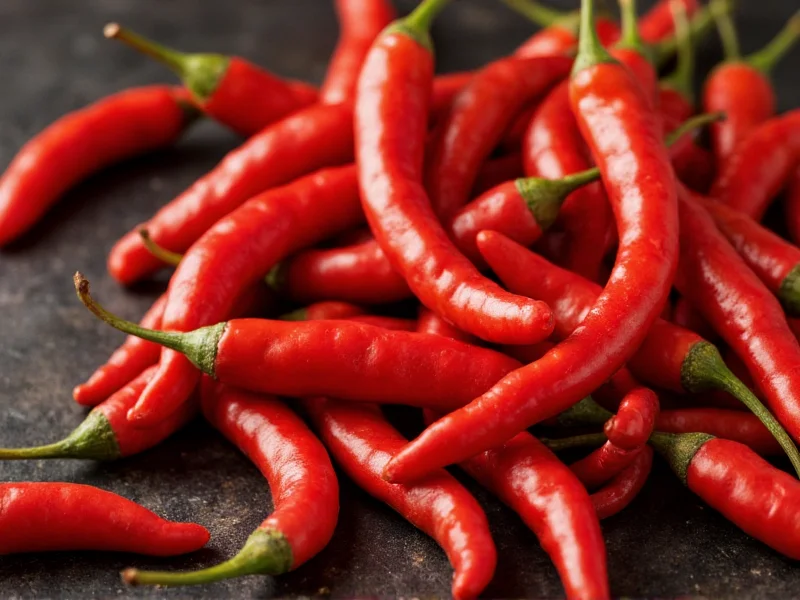When discussing the spiciest chilli peppers in the world, it's essential to understand how heat is measured and verified. The Carolina Reaper has held the Guinness World Record since 2013, but the competitive world of super-hot peppers continues to evolve with new cultivars pushing the boundaries of capsaicin concentration. This comprehensive guide examines the current champions of chili heat, the science behind spiciness measurement, and crucial safety information for those curious about these fiery fruits.
The Science of Spiciness: Understanding the Scoville Scale
Developed by pharmacist Wilbur Scoville in 1912, the Scoville Organoleptic Test originally measured pepper heat through human taste panels diluting pepper extract until the heat became undetectable. Today, High-Performance Liquid Chromatography (HPLC) provides precise measurements of capsaicinoids—the compounds responsible for heat—in Scoville Heat Units (SHU). This scientific approach has revolutionized how we verify claims about the spiciest chilli varieties.
Officially Recognized Spiciest Chillies
The Carolina Reaper, bred by Ed Currie of the PuckerButt Pepper Company in South Carolina, remains the only pepper with official Guinness World Record certification for highest heat. Its distinctive red, bumpy appearance with a characteristic tail makes it visually striking, but its heat profile delivers an intense experience that begins with fruitiness before escalating to extreme burning sensations.
| Chilli Variety | Average SHU | Guinness Recognition | Origin |
|---|---|---|---|
| Carolina Reaper | 1,641,183 | Official Record Holder (2013-present) | South Carolina, USA |
| Trinidad Moruga Scorpion | 1,200,000-2,000,000 | Previous Record Holder | Trinidad and Tobago |
| Naga Viper | 1,382,118 | Unofficial | UK |
| Ghost Pepper (Bhut Jolokia) | 855,000-1,041,427 | Previous Record Holder | India |
Emerging Contenders for World's Spiciest Chilli
While the Carolina Reaper maintains its official title, several new peppers have entered the arena with extraordinary heat claims. Pepper X, also developed by Ed Currie, reportedly reaches 3.18 million SHU according to unofficial tests. Dragon's Breath, created in Wales, claims 2.48 million SHU and has generated interest for potential medical applications as a local anesthetic alternative. However, without proper third-party verification and consistent testing protocols, these claims remain unofficial.
Safety Considerations with Super-Hot Peppers
Handling the spiciest chilli peppers requires serious precautions. Capsaicin concentrations in these extreme peppers can cause severe skin irritation, respiratory distress, and even anaphylactic reactions in sensitive individuals. Always wear nitrile gloves when handling super-hots, work in well-ventilated areas, and avoid touching your face. If exposed, use milk or oil-based products to neutralize capsaicin rather than water, which spreads the oil.
Culinary and Non-Culinary Applications
Despite their extreme heat, the spiciest chilli varieties serve purposes beyond just heat challenges. In traditional medicine, capsaicin has been used for pain relief and inflammation reduction. Law enforcement utilizes capsaicin in pepper sprays, with concentrations carefully calibrated for effectiveness without permanent damage. Culinary applications are limited but growing, with chefs using minute amounts to add complex heat profiles to dishes without overwhelming other flavors.
Common Misconceptions About Pepper Heat
Many believe that the seeds contain the most heat in chillies, but capsaicin is actually concentrated in the white pithy membranes surrounding the seeds. Another misconception is that heat equals flavor quality—while super-hots deliver intense sensations, many lack the complex flavor profiles found in moderately hot varieties. Additionally, individual tolerance varies significantly due to genetic factors affecting capsaicin receptor sensitivity.
The Future of Super-Hot Peppers
Breeding programs continue to push the limits of pepper heat, though some experts question whether there's practical value in pursuing ever-higher Scoville ratings. Future developments may focus more on flavor complexity alongside heat, or on medical applications where precise capsaicin concentrations could offer therapeutic benefits without extreme discomfort.











 浙公网安备
33010002000092号
浙公网安备
33010002000092号 浙B2-20120091-4
浙B2-20120091-4